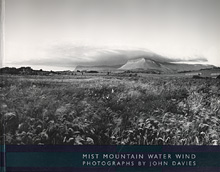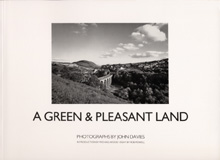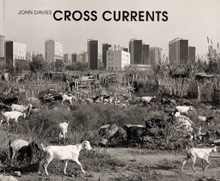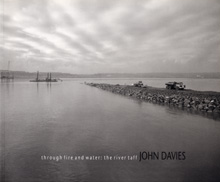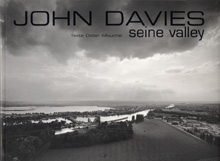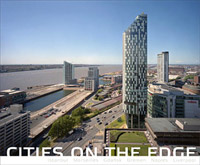-
John Davies biography
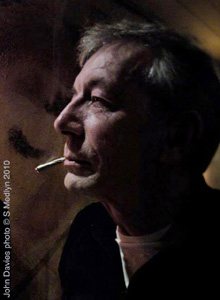
John
Davies
before he stopped smoking in 2011
-
"John Davies is one of today's most outstanding British photographers,
he became famous through his research on the English industrial
landscape, observed in vast and detailed views...
-
John Davies's work belongs to the world of contemporary documentary
photography. Faithful to a refined, pure black and white, taken
on as the absolute rule of a subtle, analytic style. He chooses
the vastness of space inhabited by the powerful elements of nature
and the contradictory ones of culture to operate in two directions.
On the one hand, the evocation of emotional states through
the photographic rendering of a space-light that is alive, almost
metaphysical, and recalls the symbolisation of the forces of nature
in Turner. On the other, a crystal-clear gaze that sounds the material
aspects of the contemporary landscape which is tied to the development
of the productive activities and concrete structuring of the world
through the molding power of economy and property".
-
Roberta Valtorta - 2000. Roberta Valtorta is photographic historian
and professor at the Museum of Contemporary Photography in Milan.
-
"In recent years I have drawn inspiration from issues relating
to my surroundings and conditioning. Initially I develop an interest
in documenting aspects of my immediate social political landscape.
These concerns often reflect a national if not international significance.
I am not so much interested in entertaining an audience or providing
vehicles for escape but in delivering a highly crafted detailed
image conveying a sense of reality. A reality that shares a recognition
of aspects of urban living. But importantly, making images of a
landscape that attempts to question our acceptance and perception
of the inevitable consequences of living in a post imperialist society
and within a post industrial landscape". John Davies - November
2011.
-
-
John Davies was born in County Durham, England, his formative years
were spent living in both coal mining and farming communities. He
studied photography in Nottingham and after graduating in 1974 he
became fascinated by the rural landscape during his visits to the
west coast of Ireland. This work focused on the forces of nature
and the interaction between sky and land. His images of Ireland,
Scotland and England, made between 1976-1981, were first published
in the monograph Mist
Mountain Water Wind 1985 and later reprinted in Skylines
1993.
-
-
In 1981 he won a one year Research Fellowship at Sheffield School
of Art and it was during this year he started to document the urbanised
landscape. He moved to Manchester in 1982 where he began to documented
key industries and the social landscapes left over from the Industrial
Revolution to reveal their impact in shaping an urban environment.
In northern England and south Wales he documented the areas of coal
mining, textiles, steel, quarrying, railways and shipping along
with the town and cities associated with these industries. This
work was published by Cornerhouse, Manchester, in the book A
Green & Pleasant Land 1987. The accompanying exhibition
was one of the Photographers’ Gallery’s (London) most
popular touring shows. A selection of this work was also shown in
a variety of international venues including the Museum of Modern
Art New York and the Pompidou Centre in Paris.
-
-
In 1991 John Davies moved to Cardiff in Wales. Between 1995 to
1996 he was invited to become a Senior Research Fellow based in
the Art School at the University of Wales Cardiff. During this
time he produced a book on the River
Taff with an exhibition of this work at the Museum
of Wales.
-
-
Since the late 1980's and increasingly throughout the 1990's he
was invited to work on numerous landscape and urbanisation commissions
in France, Italy, Spain, Holland, Belgium, Portugal, Germany, Austria
and Switzerland. His early European work was published by Ffotogallery,
Cardiff, in Cross Currents 1992. Three further monographs
were commissioned and published in France: Temps et Paysage
2000, Le
retour de la nature 2001 and Seine
Valley 2002.
-
-
The Metropoli
project started in 2000 when he started to investigate
and explore the way major British post-industrial cities had changed
from industrial and distribution hubs to consumer and cultural centres.
Between 2000-2003 he photographed Birmingham, Swansea, Belfast,
Newcastle, Gateshead, Glasgow, London, Manchester and Liverpool.
This work mainly concentrates on city centers and civic areas made
from high vantage points.
Davies was the first photographer to be commissioned by the Museum
of London in 2001 when he agreed to explore the major arterial road
links which run through the capital. It was while he was working
in London that he first started to make pigment colour prints. Ffotogallery
Cardiff, Arts Council of Wales, Birmingham Central Library, Side
Gallery, Newcastle & Gateshead City Councils, Museum of London
and Manchester Art Gallery all supported the Metropoli
project.
In 2001 Davies moved from Cardiff to Liverpool where he still lives.
In 2006 with the support of the Arts Council North West he began
to work on the Our Ground
project (web site moth-balled in 2016) which investigates
the disposal and privatisation of public open space. This work mainly
examines the public open green spaces and park land in Liverpool
that has been 'sold off' for commercial building developments. This
reflects a national phenomena: the wholesale disposal and privatisation
of public open space in towns and cities throughout Britain. As
part of the project in 2009 Davies also worked with the writer Anna
Minton and provided pictures for her book Ground
Control about regeneration, security and the privatisation
of public space. A selection of 'before and after' images from Our
Ground were first shown at The
Bluecoat in 2011.
-
-
In 2006 a selection of his British work 1979 – 2006 was published
by Chris Boot in the book The
British Landscape. A major retrospective exhibition
of these photographs launched PhotoEspaña in Madrid and then
was shown at the National Media Museum in Bradford, Galerie Vu in
Paris, Walsall Art Gallery and Cube in Manchester. Davies was short
listed for the Deutsche Börse Photography Prize 2008 for this
work.
Also in 2008 John Davies was invited to organise and curate a European
wide exhibition Cities on the Edge
and edited the book of the same title for Liverpool European Capital
of Culture 2008.
-
-
In 2009 he explored the impact and legacy of one of the first and
most notorious examples of large-scale urban regeneration in the
UK. In the 1960’s the British politician T Dan Smith’s
radical vision was to transform Newcastle-Upon-Tyne into a ‘Brasilia
of the North’. In the exhibition City State Davies’s
large-scale photographs documented the distinctive modernist designs
and the fractured marks left in the urban landscape when corruption
charges destroyed the vision.
-
-
Artist's statement
The British Landscape project is typical of my working
practice. It is a long-term ongoing project about the enormous changes
that have taken place in the UK – the world’s first
industrial society and the first to de-industrialise. This work
is self-initiated and focuses on the industrial heartlands of Britain.
I attempt to create a narrative by image sequences to tell visual
stories about process, change and transformation.
Much of Britain’s infrastructure and the rapid expansion of
industrial cities were created through the unprecedented growth
of the Industrial Revolution. By the early 1980’s, when I
started this project, many of these large-scale industries and industrial
communities were in terminal decline.
The British Landscape is both a coherent body of work using
image as metaphor and an historical topographic survey, viewed from
an independent contemporary perspective, of the remains of massive
industrial and population growth and the impact of subsequent de-industrialisation,
shrinkage, regeneration and experiments in planning new communities.
I show urban development through a multi-layered perspective that
captures moments in the stories of a continually changing and expanding
urban structure. I do not attempt to simplify the complex evolution
of a post-industrial and post-imperialist society but explore our
relationship to the multi-faceted layers of our urbanised landscape.
I document an economy that is now divorced from geography and the
evident social consequences of this.
These photographs are made deliberately in an un-sensational and
often understated way to allow the viewer to draw their own conclusions
and to avoid imposing my own view of urban change. I do use text
purposefully alongside my images to give political, social and historical
context to specific structures and places. For example, I factually
describe the changes in the use of old industrial buildings that
have become transformed for a ‘new economy’ of financial
services, administration, retail and leisure.
A fundamental aspect of my approach to landscape is the sense of
power it can symbolise and evoke. Images of land, water and sky
can become metaphors, which reflect our emotional and spiritual
states. But the landscape can also represent power in terms of land
ownership and material wealth. It is this dual and often ambiguous
representation of the metaphysical and the material in the landscape
that underlies my photographic work. I believe in the beauty of
truth rather than the truth of beauty even though the meaning of
visual truth can be challenging and often fluid. My work attempts
to raise questions about our collective responsibility in shaping
the environments in which we live.
John Davies
-
-
Photo and material Copyright © John
Davies 1976-2019. All rights reserved
|

